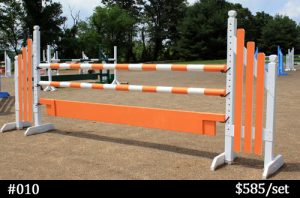 Horse jumping is a beloved sport that tests the bond between a horse and their rider. Courses can take on many shapes, forms, and configurations. A common component of these arenas is the use of horse jump poles. When designing your course, it is up to you to make some essential decisions. For instance, will the course be for experienced riders or beginners? In this post, we will briefly discuss some important design concepts.
Horse jumping is a beloved sport that tests the bond between a horse and their rider. Courses can take on many shapes, forms, and configurations. A common component of these arenas is the use of horse jump poles. When designing your course, it is up to you to make some essential decisions. For instance, will the course be for experienced riders or beginners? In this post, we will briefly discuss some important design concepts.
If you are designing a course for beginners, then you may want to prioritize a course that stresses fundamentals versus a highly technical layout. One way you can build the confidence of both the horse and rider is to space out horse jumps and cavalettis at reasonable intervals. These additions to a course are meant to test a pair’s ability to negotiate momentum and speed when faced with an obstacle.
Jumps and cavalettis are that are spaced too close to one another may cause a horse to slow down, which causes poor judgment calls that can lead to a crash. This has the potential to hurt both the horse and the rider, so some caution must be exercised to minimize the risk of injury.
The distance that you will want to set jump poles and other gates will vary between horse and rider pairs. If you are designing a course for training new horses and riders, then it would make sense to provide sufficient space between one obstacle and another. As the pairs become more familiar with the motions and momentum, they can move onto more complex or custom tracks.
When designing a course, it is important to consider the sensibilities of both the rider and the horse. Small obstacles build confidence and allow horse and rider pairs to improve their skills gradually. Sufficiently spaced out horse jump poles allow teams to learn while strengthening their abilities.

